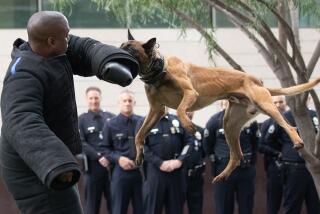A farcical attack on Hitler taboos
- Share via
BERLIN — In a wacky corner of cyberspace, rubber duckies with Adolf Hitler faces sing in the bathwater. Their voices in unison, they bob to reggae music as bombs fall on Berlin, while the Fuehrer himself, a manic cartoon trapped in a bunker, sings: “Surrender? No, it’s not my cup of tea.”
The voice belongs to Thomas Pigor, a cabaret singer with a mischievous sense of timing. He and irreverent comic-book writer Walter Moers collaborated on the short video “Adolf -- The Bonker.” Mocking Hitler’s southern German accent with the pronunciation “bonker” instead of bunker, the clip has been viewed more than 4 million times on YouTube and other sites since its Internet debut in July.
“It’s a blasphemous joy to see Hitler shrunk into this tiny, pathetic cartoon figure. It destroys the myth of the cult figure some still hold,” Pigor said, sitting near a candelabrum on a drizzly afternoon. “I didn’t anticipate such a hit. I thought it would only be big on the cabaret scene. But its popularity shows that the time is ripe for breaking the Hitler taboo.”
The Hitler era is gingerly approached in this nation. Since World War II, the image of the Fuehrer has largely been one-dimensional: a madman held in the wings.
But in recent years, most notably with the 2004 Academy Award-nominated film “The Downfall,” Hitler’s tics and foibles, his darting eyes and nervous hands, have drawn a fuller image of the man responsible for the Holocaust.
This fascination has led to wider interpretation, including a comedy scheduled for release early next year. The movie, “My Fuehrer: The Truly Truest Truth About Adolf Hitler,” by Jewish director Dani Levy, portrays the former German leader as a drug-addicted bed-wetter.
Such parody and farce in re-imagining Nazi history are playfully evident in Pigor and Moers’ cartoon video.
The nearly three-minute clip depicts a naked Hitler shaving, sitting on the toilet and taking a bath with his dog Blondi.
The bunker is a speck in a ruined landscape where a delusional Hitler frets and sneers through an annoying nasal twitter: “I’m sitting in my bunker in the middle of Berlin,” he sings. “I’ve got cyanide capsules and plenty of gasoline. The Luftwaffe is kaput. The Messerschmitt’s a bore. The Second World War isn’t fun anymore.”
The rubber ducky chorus, popping up through bubbles and sounding a bit like a trio of singing sisters from a 1940s musical, chimes to a reggae tune: “Adolf you bloody Nazi pig. Won’t you capitulate? Adolf
The video promotes Moers’ elaborate comic book of the same name, the final installment in a Hitler trilogy that includes cameos by Mussolini and Gandhi.
Moers declined an interview request, but Pigor, who has parodied Hitler for a decade in his cabaret act, said the artist and author approached him about being the Fuehrer’s voice. The two worked on the lyrics and music; Pigor said the clip may be broadened into a movie.
“Moers had the basic idea for the song, but I polished it and put some music in,” said Pigor, known for his politically incorrect riffs.
“We wanted to show Hitler involved in the banalities of everyday life. I’m not a qualified Hitler imitator, so I tried out Hitler voices, soft, loud, crying, making love. And, of course, in this clip I had to use a banal voice because it’s set in a bathroom in the bunker.”
He added: “Jewish intellectuals criticized the video for lacking historical context, and Internet discussions among neo-Nazis complained that the clip was Jewish propaganda. Some threatened us that we will see blood.”
Sitting at his kitchen table, Pigor wore a blue sweater and big-rimmed glasses, his thinning hair combed toward his forehead in pointy shards. He had the coy eyes of a prankster -- he once set German philosopher Martin Heidegger’s postmodern musings to hip-hop -- and seemed intrigued by the attention a snippet on YouTube can bring.
“I think that we are at a point in time when we can look at Hitler differently,” he said. “We Germans have had three phases of digesting the Nazi past. The first came in the 1950s and that was all about pushing it under the carpet.
“The second came in the 1960s when the young generation questioned how the Nazis arose under the noses of their parents.
“The third is that those who lived through World War II -- perpetrators and victims -- are dying and Hitler can be examined in other ways.”
More to Read
Only good movies
Get the Indie Focus newsletter, Mark Olsen's weekly guide to the world of cinema.
You may occasionally receive promotional content from the Los Angeles Times.










